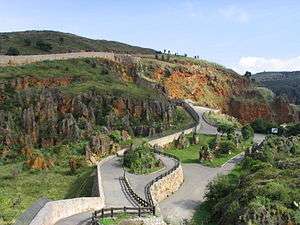Cabarceno Natural Park
|
Park grounds | |
| Date opened | 1989 |
|---|---|
| Location | Penagos (Cantabria) |
| Coordinates | 43°21′00″N 3°51′08″W / 43.35000°N 3.85222°WCoordinates: 43°21′00″N 3°51′08″W / 43.35000°N 3.85222°W |
| Land area | 750 ha (1,900 acres) |
| No. of species | >112 |
| Memberships | EAZA[1] |
| Major exhibits | Raptors, sea lions |
| Website |
www |
The Natural Park is located in Cabárceno, Pisueña Valley (region of Pas-Miera) 17 kilometres (11 mi) from Santander, located in a former iron mine in the town of Cabárceno Township Penagos (Cantabria, Spain).[2] The park belongs to Cantur, a company whose purpose is the promotion of tourism and which is owned by the Government of Cantabria.
Cabárceno Park has two roles: one is the conservation of endangered species and the other is environmental education.
Cabárceno Park
The natural park of Cabárceno is neither a conventional zoo nor a natural park (parque natural) in the normal Spanish use of the term. It is a naturalized space reclaimed from 750 hectares (1,900 acres) of a former open pit mine to the primitive beauty of the karst landscape.
The natural park is home to a hundred animal species from five continents living in semi-free conditions, which are distributed in large enclosures where one or more species coexist.
Except for food provided to them, the rest of the animal's activities are marked by their almost total freedom. Almost all of them trigger fights and mating season struggles for control of females.
More than 20 kilometres (12 mi) of roads cross the park, leading to gorges, lakes, and rock figures. Throughout the park are parking areas and trails.
Reptiles
Poisonous snakes such as cobras, rattlesnakes, and giant snakes, and turtles and lizards, can be seen. The reptiles' section is located at the entrance of Obregon Park, next to the café La Mina.
Animals
The park has many animal species, for example:
_-_2013-Aug-12_-_by_Stromare.jpg)

Facilities
The Nature Park Cabárceno hosts throughout the year thousands of people.
The facilities that host animals are internationally recognized as one of the best there exist in the world.
Facilities available at the park include nursing, public phones, ATM, reptiles, environmental classroom, picnic areas, parking areas, self-service, cafeteria, restaurant, and souvenir shops.
- Restaurant “Bears”
Located in the heart of the Park, opposite the exhibition of ostriches and antelopes. A cafeteria and souvenir shop, with snacks, sandwiches and drinks. It has a terrace with the bear enclosure in the background. The Restaurant "Bears" has a capacity for 280 diners.
- Self – service “The Farm”
Located in the area of environmental education, has a capacity of 400 guests.
- Restaurant “Holly Lake”
Located next to the elephant enclosure and the lake of the same name.
- Restaurant “Mine”
Located next to the reptile house at the main entrance of the park. It has a gift shop and terrace.
Botanical routes
There are 24 of the 100 trees in the park grown in three of the most visited places: tigers, hyenas, wolves and lions.
Botanical paths are paths that are located near animal enclosures, in which plant species are displayed.
- Route of the yews, oaks and hickories
In the gardens there are yew, oak, walnut, bamboo, birch, olive, oak, pine, cherry, horse chestnut, alder, oaks, holly, cypress, laurels, figs, bananas, strawberry, laurel, oleander, Atlas cedar, ginkgo, an ornamental barberry (Bordeaux color), mock orange, pistosporos, etc. ..
- Route of the birch, linden and beech
Hyenas: birch, olive, cherry, oak (also known as cajiga or Carbayo), oaks, chestnut oaks, elders, etc.
Lobos: laurel, willow, oak, lime and beech trees.
- Route of the chestnut and pine
Pines, olive trees, oaks, chestnut, fig, maples, oaks, chestnuts pines, maritime pine trees, cherry, medlar, oleander, Pyracantha, cordelynes, griñoleras, etc.
Environmental education center
The Environmental Education Workshop Nature Park Cabárceno has educational programs for grade levels between 3 and 18.
Scientific activity
One of the issues that justify the existence of zoos today in addition to the conservation of endangered species is undoubtedly the ability to undertake research to assist the conservation of these species.
So the park has pioneered, in collaboration with the Deutsches Primatenzentrum and the University of Göttingen (Germany), the development of techniques that have allowed the knowledge of the sexual cycle in female African elephant by noninvasive methods (using samples feces and urine).
The park collaborates in behavioral studies of the male African elephant, verifying, also by non-invasive, hormone profiles and thereby study the reason for the highly aggressive showing male elephant at certain times of the year. Known by the name "Musht", in this state the male is dangerous and causes accidents.
The park collaborates with zoos and partnerships in the conservation of endangered species like tigers, lions, bobcats, rhinos, etc.
The park is a member of AIZA and EAZA (Iberian Association of Zoos and Aquaria European), of Endangered Species threatened with Extinction (EEP) and in the herd books (studbook) of most species in the park.
References
- ↑ "EAZA Member Zoos & Aquariums". eaza.net. EAZA. Retrieved 28 January 2013.
- ↑ "Cabárceno Wildlife Park: a world of nature and surprises for the little ones". Turespaña / Segittur. Retrieved 18 January 2013.
External links
- Information about Cabarceno The best and newest information about Cabarceno natural park
 Media related to Cabárceno natural park at Wikimedia Commons
Media related to Cabárceno natural park at Wikimedia Commons- Official website
